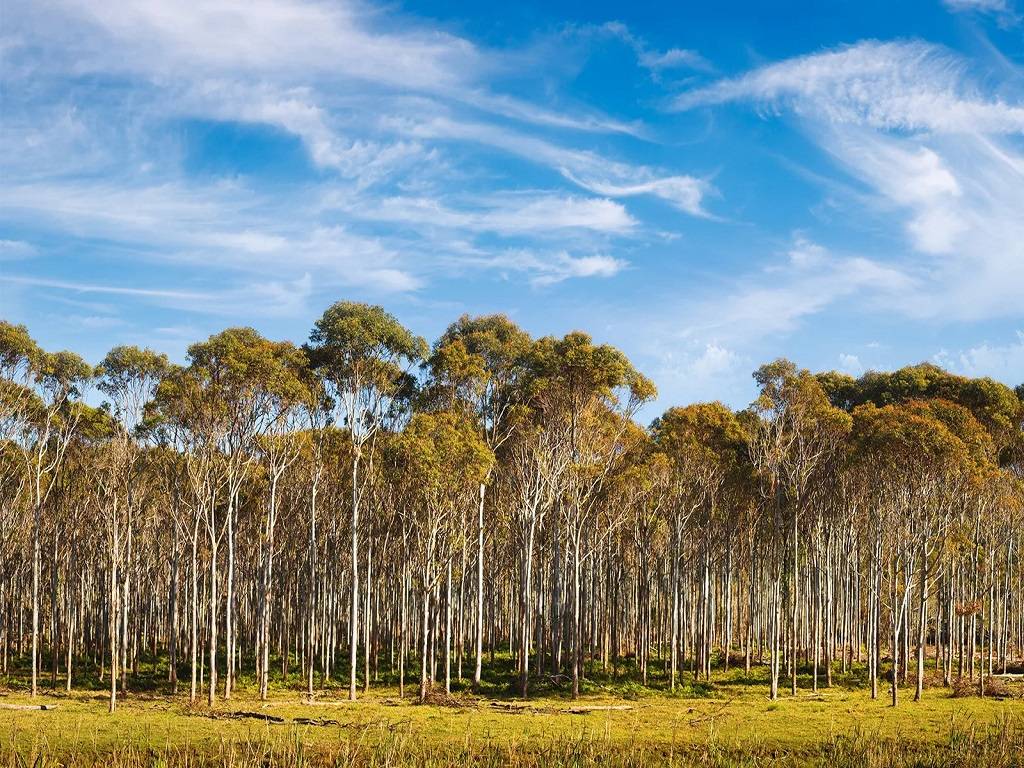
Eucalyptus is a medium-sized to a large, fast-growing tree that may grow to be 25 meters to 50 meters tall and 2 meters in diameter. This tree is a member of the "Myrtaceae" family, which has over 325 species. Eucalyptus is endemic to Australia, Tasmania, and the surrounding islands.
Essentially, the British introduced Eucalyptus around 1843 in the Nilgiri highlands of Tamil Nadu for fuel and wood uses. This tree is also known as a "gum tree," a "red iron tree," and a "Safeda or Nilgiri tree."
The primary commercial species are Eucalyptus grandis and Eucalyptus tereticornis. Eucalyptus leaves and oil are well-known for their therapeutic benefits and are also utilized in herbal goods.
Eucalyptus Growing Conditions:
-
In general, forest trees are single-stemmed, with a minimal part of the tree's height forming the crown.
-
Eucalyptus trees demand a high temperature, however certain species, such as E. Neglecta and E. Crenulata, can survive in semi-shaded regions. They adapt well to a broad range of soil conditions, from hot and dry to somewhat damp, as long as the area is well-drained.
-
Depending on region and climate, you can plant Eucalyptus in mid to late spring or fall. It is necessary to water the tree both before and after planting.
Required Climatic Conditions
Eucalyptus can be cultivated in a wide range of climates. It does, however, grow best in tropical climates. Eucalyptus trees can be cultivated in India in temperatures ranging from 0°C to 47°C.
Soil Preparation
It is necessary for the good growth of Eucalyptus to have soil with high drainage capability. It can be grown in several soil types, but it grows best in well-drained, organic-rich loamy soils. Waterlogged, alkaline, or saline soils are not suited for growing eucalyptus.
Time of Sowing
The optimum time for planting Eucalyptus is from June to October.
Transplanting And Nursery Management
Eucalyptus can be grown both by seed and by vegetative propagation. Prepare raised beds in the shade for the nursery and put seedlings in them. Seedlings develop quickly at temperatures ranging from 25 to 35°C.
Six weeks after planting, or at the second leaf pair stage, seedlings are ready for transfer in a polythene bag. They are suitable for field transplanting 3-5 months after seeding. The majority of field transplantation occurs during the wet season.
Irrigation
Irrigation should begin as soon as the seedlings are placed in the main field. Drip irrigation may be used to maintain moisture in place. The amount of irrigation, however, is determined by the soil type and weather circumstances.
Even though eucalyptus is a drought-tolerant tree, around 25 irrigations should be carried out over the entire growth period for speedy returns and high output (especially in the summer or hot dry season). There is no requirement for irrigation during the wet season.
This tree can survive water stagnation. In the event of extreme floods or rain, however, it is advised to drain the soil.
Harvest and Yield
It takes between 10 and 12 years for the eucalyptus plants to mature and become trees. Its cultivation costs less as well. A eucalyptus tree weighs around 400 kg, approximately.
In a one-hectare area, around one to one and a half thousand trees can be planted. Farmers can easily make 70 lakhs to one crore by selling these woods once the tree is ripe.
Intercropping in Eucalyptus
Farmers cultivating eucalyptus can plant short-duration profitable crops such as turmeric, ginger, linseed, and garlic in between the rows of the eucalyptus tree. These crops help in reducing the cost of the cultivation of eucalyptus.
Limitations of Growing Eucalyptus
Eucalyptus depletes the nutrients and moisture reserves of the soil and inhibits the undergrowth due to allelopathic properties. It is also found that the decomposition of the dead plant leaves and barks is very slow resulting in a slow nutrient cycle. Therefore, eucalyptus farming is not recommended for areas where the water table is depleting. It should be done in areas that have excess water.
















